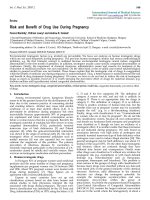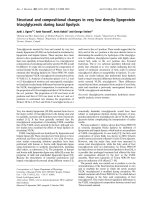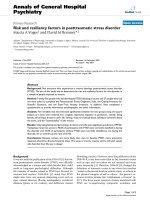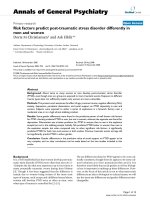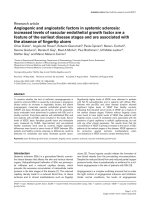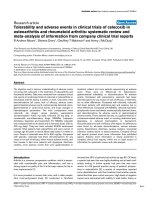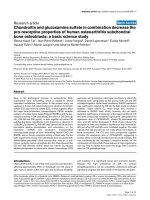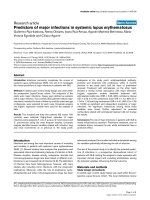Báo cáo y học: "Risk and resiliency factors in posttraumatic stress disorder" pptx
Bạn đang xem bản rút gọn của tài liệu. Xem và tải ngay bản đầy đủ của tài liệu tại đây (282.06 KB, 9 trang )
BioMed Central
Page 1 of 9
(page number not for citation purposes)
Annals of General Hospital
Psychiatry
Open Access
Primary Research
Risk and resiliency factors in posttraumatic stress disorder
Marcia A Voges
1
and David M Romney*
2
Address:
1
Department of Psychology, University of Calgary, Calgary, Alberta, Canada T2N 1N4 and
2
Division of Applied Psychology, University
of Calgary, Calgary, Alberta, Canada T2N 1N4
Email: Marcia A Voges - ; David M Romney* -
* Corresponding author
Abstract
Background: Not everyone who experiences a trauma develops posttraumatic stress disorder
(PTSD). The aim of this study was to determine the risk and resiliency factors for this disorder in
a sample of people exposed to trauma.
Method: Twenty-five people who had developed PTSD following a trauma and 27 people who had
not were asked to complete the Posttraumatic Stress Diagnostic Scale, the Coping Inventory for
Stressful Situations, and the State-Trait Anxiety Inventory. In addition, they completed a
questionnaire to provide information autobiographic and other information.
Analysis: Five variables that discriminated significantly between the two groups using chi-square
analysis or t-tests were entered into a logistic regression equation as predictors, namely, being
female, perceiving a threat to one's life, having a history of sexual abuse, talking to someone about
the event, and the "intentionality" of the trauma.
Results: Only being female and perceiving a threat to one's life were significant predictors of PTSD.
Taking base rates into account, 96.0% of participants with PTSD were correctly classified as having
the disorder and 37.0% of participants without PTSD were correctly classified as not having the
disorder, for an overall success rate of 65.4%
Conclusions: Because women are more likely than men to develop PTSD, more preventive
measures should be directed towards them. The same is true for trauma victims (of both sexes)
who feel that their life was in danger
Background
It was not until the publication of the DSM-III [1] that the
term posttraumatic stress disorder (PTSD) was officially
acknowledged as a unique and valid disorder that could
result in long-term psychological difficulties. Although
the majority of studies related to PTSD have focused on
veterans and warfare, DSM-III-R [2] noted that PTSD
might arise from any unusual distressing event such as
rape, natural disasters (floods, earthquakes), accidental
disasters (plane or car crashes), and deliberate trauma
(bombing, torture). However, since the publication of the
DSM-III-R, it has been noted that in fact traumatic events
such as rape and car crashes are not unusual and occur
quite frequently [3]. Therefore, DSM-IV [4] changed the
definition of traumatic events to any event that involves
"actual or threatened death or serious injury, or a threat to
the physical integrity of self or others the person's re-
sponse involves intense fear, helplessness, or horror" (p.
427). The three major symptom clusters associated with
PTSD are re-experiencing symptoms, avoidance and
Published: 1 May 2003
Annals of General Hospital Psychiatry 2003, 2:4
Received: 16 December 2002
Accepted: 1 May 2003
This article is available from: />© 2003 Voges and Romney; licensee BioMed Central Ltd. This is an Open Access article: verbatim copying and redistribution of this article are permitted
in all media for any purpose, provided this notice is preserved along with the article's original URL.
Annals of General Hospital Psychiatry 2003, 2 />Page 2 of 9
(page number not for citation purposes)
numbing symptoms, and symptoms of increased arousal
[4].
The most recent epidemiological study [5] estimates that
about 90% of citizens in the US are exposed to at least one
traumatic event during their lives, with many being ex-
posed to more than one trauma throughout their life. De-
spite this high incidence, in recent years it has become
evident that PTSD does not occur in everyone who is ex-
posed to traumatic events. Severity of the traumatic event
has been implicated as one of the most salient predictors
of PTSD [6]. Results of the National Comorbidity Survey
indicated that traumatic events such as torture and sexual
assault were associated with the highest rates of chronic
PTSD, whereas lower magnitude events such as motor ve-
hicle accidents and life-threatening illness were associated
with lower rates of trauma [7]. However, even among
those who are exposed to very severe traumatic events,
only a fraction of those individuals go on to develop PTSD
[5,6]. Therefore, it is important to determine why some
individuals exposed to traumatic events develop PTSD
and others do not. The observation that trauma per se is
not a sufficient determinant of PTSD raises the possibility
that there may be particular risk factors that make an indi-
vidual vulnerable towards developing a disorder [8]. Risk
factors can be divided into two main categories: severity
and type of traumatic event, and predisposing personal
characteristics such as personality and gender [9].
Sex Differences
In general, women are more at risk than men for PTSD fol-
lowing exposure to traumatic events. Research indicates
that although women are less likely to be violently as-
saulted than men (such as being beaten up or mugged),
they are much more likely to be sexually assaulted, includ-
ing being raped. Men, on the other hand, are more likely
to have been in serious accidents (such as car crashes) and
to have witnessed acts of violence. The conditional risk of
PTSD associated with any kind of trauma, however, is dou-
ble in women – 13% as opposed to 6% – demonstrating
that the higher rates of PTSD in women are not due solely
to their more frequent exposure to rape. Although women
do experience rape more often than males, this accounted
for only a part of the sex difference in the conditional risk
of PTSD. In other words, women are more vulnerable to
PSTD following any kind of physical assault, sexual or
otherwise [10].
Multiple Risk Factors
A number of studies [11–17] have examined the effects of
various risk factors acting together to promote the devel-
opment of PTSD. For example, one study [11] examined
the following combination of risk factors to predict who
developed chronic PTSD: age of exposure to the traumatic
event, family history of psychiatric disorders, a history of
prolonged childhood separation from parents, personali-
ty factors, and sociodemographic characteristics. In this
study, being female, separation from parents in child-
hood, and family and personal history of psychopatholo-
gy were significant predictors of PTSD.
Coping Factors
Coping has been defined as the processes that individuals
use to modify adverse aspects of their environment as well
as to minimize internal threat induced by stress [18]. Pre-
vious research has suggested that the way people process
and interpret traumatic events and its consequences may
play a role in the development or maintenance of PTSD
[15,19,20].
For instance, victims of a boating accident who displayed
avoidant behaviour and who spent less time attempting to
work through their experiences manifested traumatic
symptoms, somatic symptoms and fears eight months af-
ter the accident. This finding implies that the kind of cop-
ing strategy used by those exposed to traumatic events
affects the development of the disorder [20].
Another study [21] examining the role of cognitive proc-
esses in the development of PTSD investigated the attribu-
tions of responsibility of motor vehicle accident (MVA)
victims. Most of the 152 participants attributed the re-
sponsibility of the MVA to someone else as opposed to
themselves (64% v. 9%). Among the 62 participants who
were initially diagnosed with PTSD, 66% attributed re-
sponsibility for the accident to someone else whereas only
8% of those with PTSD attributed responsibility to them-
selves. This study supports the notion that those victims
who accept the responsibility or blame for their trauma
cope better with the aftermath than those who blame
someone or something else. Identical conclusions were
drawn from the results of similar study into PTSD and
MVAs [22]. However, taking responsibility for one's ac-
tions is only therapeutic when one has control over the
traumatic events; when events are beyond one's control,
self-blame is destructive [23]. These findings can only be
generalized to those who experienced a MVA; therefore,
more research to determine whether these findings of at-
tribution of responsibility hold for other types of trauma
such as rape or torture is needed.
Purpose
The purpose of the present study was to determine the risk
and resiliency factors for PTSD by comparing a group of
people who experienced a traumatic event and developed
PTSD with a group of individuals exposed to trauma who
did not develop the disorder. The inclusion of a group of
trauma-exposed participants without PTSD greatly en-
hances the information that can be obtained from cross-
sectional studies [9]. If premorbid differences are
Annals of General Hospital Psychiatry 2003, 2 />Page 3 of 9
(page number not for citation purposes)
uniformly present in individuals with PTSD but are absent
from traumatized individuals without PTSD, then the dis-
order is not due to exposure to the traumatic event alone;
it must be a product of both stress and predisposing fac-
tors such as heightened sensitivity or inability to cope [9].
In addition, to our knowledge, there are no studies which
have examined the role attributions of responsibility in
those experiencing traumatic events other than MVAs, and
few studies have examined the relationship between cop-
ing style and PTSD.
Method
Sample
Fifty-two individuals of both genders who had been ex-
posed to traumatic events were recruited from the Univer-
sity of Calgary and the Calgary fire stations, and through
the media (i.e., newspaper advertisements and radio an-
nouncements). Volunteers were included if they were be-
tween the ages of 18 and 65 and had experienced a
traumatic event. Informed consent was obtained from all
the participants who could then either make an appoint-
ment to complete the measures in person or have the
questionnaires mailed to their homes. The measures took
approximately 15 to 25 minutes to complete.
The diagnosis of PTSD was made utilizing the Posttrau-
matic Stress Diagnostic Scale (PDS) which has an accept-
able diagnostic utility, with a sensitivity of .82, a
specificity of .77, and a kappa of .59 [24].
Measures
Posttraumatic Stress Diagnostic Scale [24]
The PSD is a 49-item self-report instrument that measures
all six criteria for PTSD in the DSM-IV [4]. The scale com-
prises a 13-item checklist of possible traumatic events,
and respondents are required to indicate which events
they have experienced. They then rate which traumatic
event was most stressful for them and, subsequently, this
event is the one that is assessed. A diagnosis of PTSD is
made only if all six DSM-IV criteria are met (4).
Coping Inventory for Stressful Situations [25]
The CISS is a 66-item multidimensional measure that as-
sesses task-oriented coping, emotion-oriented coping,
and denial. Respondents are asked to indicate how much
they engage in various types of activities when they en-
counter a difficult, stressful, or upsetting situation on a 5-
point scale ranging from not at all to very much.
State-Trait Anxiety Inventory [26]
This inventory has two separate self-report scales, one for
measuring state anxiety and another for measuring trait
anxiety. For the purposes of the present study only the S-
Anxiety scale was utilized. The S-Anxiety scale contains
twenty statements that evaluate how respondents feel
"right now, at this moment" with respect to feelings of ap-
prehension, tension, nervousness, and worry. The S-Anxi-
ety scale may also be used to evaluate how respondents
felt at a particular time in the recent past, which is how this
measure was used in the present study. To obtain a measure
of the degree of stress or anxiety at the time of the traumat-
ic event, participants were asked to answer the inventory
in terms of how they felt during their traumatic event.
Ad Hoc Questionnaire
A questionnaire was designed especially for the purpose
of this study to assess vulnerability and resiliency factors
identified in the literature such as gender, education level,
child abuse, personal and familial history of psychopa-
thology, early separation from parents, attribution of re-
sponsibility, severity of the trauma, and social support.
The full questionnaire may be found in an Appendix (see
additional file 1).
Analysis
Chi-square and t-tests were conducted to determine which
variables differentiated significantly between the two
groups. These variables were then included as predictor
variables in a logistic regression analysis. It should be not-
ed that in order to avoid capitalizing on chance, the rule
of thumb recommended by most statisticians is for there
to be a minimum of ten subjects for each predictor varia-
ble in the equation [27].
Results
Of the 52 participants who were exposed to traumatic
events, 48% met DSM-IV criteria for current PTSD. There
were more women (n = 31) than men (n = 21) in the sam-
ple and average age of the sample was 36.8 (9.76) years.
In descending order of frequency, the types of trauma re-
ported were physical assault (n = 14), accident (n = 10),
sexual assault (n = 9), combat (n = 5), sudden death of
family member (n = 4), suicide of family member (n = 4),
and life threatening illness (n = 3). More females (76.0%)
developed PTSD than males (24.0%), a difference that
was found to be statistically significant, chi-square = 5.37,
df = 1, p = .02. Those with PTSD had a higher frequency of
being unmarried than those without PTSD (56.0% vs.
29.6%) but this finding was not significant. Those with-
out PTSD seemed better educated than those with PTSD
although the difference was not statistically significant.
There was also no significant difference between the two
groups at the time since the traumatic event occurred. Re-
fer to Table 1 for complete information on demographic
characteristics.
Approximately equal numbers of participants with PTSD
(88.0%) and without PTSD (88.9%) reported having ex-
perienced at least one other traumatic event during their
Annals of General Hospital Psychiatry 2003, 2 />Page 4 of 9
(page number not for citation purposes)
lifetime. Although not statistically significant, those with
PTSD (40.0%) were more than twice as likely as those
without PTSD (18.5%) to have had a history of physical
abuse as a child. Participants with and without PTSD had
similar frequencies of family history of mental illness, per-
sonal history of mental illness, and being raised by some-
one other than their parents for at least four months prior
to the age of 16 (see Table 2). Having a history of sexual
abuse as a child was found to be more common in those
with PTSD (56.0%) than those without PTSD (22.2%), a
statistically significant finding, chi-square = 6.26, df = 1, p
= .02.
Both those with and without PTSD had similar frequen-
cies for receiving physical injuries as a result of their trau-
ma, having to be hospitalized due to the event, and
witnessing the death or severe injury of another person
(see Table 3). A significant difference was found, however,
depending on whether they were the victims or the wit-
nesses of a traumatic event – 84.0% of participants with
PTSD were victims whereas 44.4% of those without PTSD
were witnesses, chi-square = 8.76, df = 1, p = .004.
The results from the S-Anxiety scale revealed no signifi-
cant differences between those with and without PTSD on
the degree of anxiety experienced while the traumatic
event was occurring: 68.40 (13.03) vs. 64.41 (12.55).
Again, there was no significant difference between those
with and without PTSD on the reported severity of injuries
they received as a result of the trauma: 3.48 (1.56) vs. 4.00
(1.57). However, significant differences were found be-
tween participants on the extent to which they felt that
their life was in danger, those with PTSD reporting a high-
er mean score than those without PTSD: 3.84 (1.52) vs.
2.44 (1.40), t (50) = 3.45, p = .001. Significant differences
were also found on the extent to which participants felt
that their traumatic event was the result of an intentional
act, those with PTSD reporting a higher mean score than
those without PTSD: 3.92 (1.53) vs. 2.81 (1.90), t (50) =
2.30, p = .026. There were no significant differences to the
extent to which participants with or without PTSD report-
ed obtaining professional support to deal with their
traumatic event or having prior training in dealing with
traumatic events (see Table 4 for frequency counts).
There were no differences found between groups on attri-
bution of responsibility for the traumatic event – those
Table 1: PTSD and Demographic Factors
Total PTSD (n = 25) No PTSD (n = 27)
Sex
Male 21 (40.4%) 6 (24.0%) 15 (55.6%)
Female 31 (59.6%) 19 (76.0%) 12 (44.4%)
Marital Status
Married 30 (57.7%) 11 (44.0%) 14 (51.9%)
Not Married 22 (42.3%) 14 (56.0%) 8 (29.6%)
Education
Some high school 6 (11.5%) 5 (20.0%) 1 (3.7%)
High school diploma 6 (11.5%) 3 (12.0%) 3 (11.1%)
Some college 12 (23.1%) 5 (20.0%) 7 (25.9%)
College degree 12 (23.1%) 4 (16.0%) 8 (29.6%)
Trade certificate 8 (15.4%) 5 (20.0%) 3 (11.1%)
Post-Graduate degree/Professional 8 (15.4%) 3 (12.0%) 5 (18.5%)
Table 2: PTSD and Early Environmental Factors
PTSD (n = 25) No PTSD (n = 27) p-values
History of previous trauma 22 (88.0%) 24 (88.9%) 1.000
History of sexual abuse 14 (56.0%) 6 (22.2%) .022
History of physical abuse 10 (40.0%) 5 (18.5%) .127
Family history of mental illness 18 (72.0%) 15 (55.5%) .219
Personal history of mental illness 8 (32.0%) 5 (18.5%) .212
Child separation from parents 7 (28.0%) 7 (25.9%) 1.000
Annals of General Hospital Psychiatry 2003, 2 />Page 5 of 9
(page number not for citation purposes)
with and without PTSD were both more likely to blame
others for their traumatic event as opposed to blaming
themselves. Those with PTSD were more likely to use
emotion-oriented coping in dealing with stressful events
than those without PTSD. This finding approached signif-
icance, chi-square = 5.74, df = 1, p = .06. Significant differ-
ences were found between groups depending on whether
or not someone was available to talk to about their trau-
ma. Of those with PTSD, only 40.0% reported having
someone available to talk to in contrast to 81.5% of those
without PTSD, chi-square = 9.44, df = 1, p = .004. Similar-
ly, the groups differed on the extent to which they talked
about their traumatic event with others – those with
PTSD, on average, spoke less about their traumatic event
with others than those without PTSD: 2.32 (1.38) vs. 3.33
(1.14), t (50) = -2.90, p = .006.
A direct logistic regression analysis was performed using
the five variables that significantly discriminated between
the two groups as the variables that would in combination
best predict the probability of having PTSD. These varia-
bles were:
• gender
• having a history of sexual abuse
• the extent to which one felt one's life was in danger
• the extent to which one felt that the traumatic event was
the result of a deliberate act
• whether or not there was someone to talk to about the
traumatic event.
According to the Wald criterion, gender and the extent to
which participants felt their lives were in danger reliably
predicted PTSD, z = 2.20, p < .05 and z = 2.04, p < .05. Fe-
males were 7.6 times more likely to have PTSD than males
and a one-unit increase in the extent to which participants
felt their life was in danger multiplied the odds of having
PTSD 1.7 times. Using the default cut point of .5, predic-
tion success was above chance with 72.0% of participants
with PTSD correctly classified as having the disorder and
81.5% of participants without PTSD correctly classified as
not having the disorder, for an overall success rate of
76.9%.
Because the prevalence rate of PTSD varies depending on
the type of trauma experienced, another analysis was con-
ducted using a cut point of .17, which is the average prev-
alence rate for PTSD across several studies reported in the
literature. Consistent with the previous results, this analy-
sis also found that gender and the extent to which one felt
their lives were in danger reliably predicted the presence
or absence of PTSD, z = 2.20, p < .05 and z = 2.04, p < .05.
However, using this cut-point of .17, 96.0% of
participants with PTSD were correctly classified as having
the disorder and only 37.0% of participants without PTSD
Table 3: PTSD and Severity of Trauma
PTSD (n = 25) No PTSD (n = 27) p-values
Physical injuries 16 (64.0%) 10 (37.0%) .095
Hospitalization required 9 (36.0%) 6 (22.0%) .362
Witness death or severe injury 9 (36.0%) 16 (59.3%) .107
Direct experience of trauma 21 (84.0%) 12 (44.4%) .004
Table 4: PTSD and Social Support and Coping
PTSD (n = 25) No PTSD (n = 27) p-values
Persons available to talk to about trauma 10 (40.0%) 22 (81.5%) .004
Professional support 13 (52.0%) 14 (51.9%) 1.000
Training in dealing with trauma 2 (8.0%) 6 (22.2%) .252
Self-blame for trauma 0 (0.0%) 1 (3.1%) .391
Blame others for trauma 14 (43.8%) 17 (53.1%) .332
Problem-oriented coping 3 (12.0%) 9 (33.0%) .077
Emotion-oriented coping 14 (56.0%) 7 (25.9%) .057
Avoidance-oriented coping 8 (32.0%) 11 (40.7%) .480
Annals of General Hospital Psychiatry 2003, 2 />Page 6 of 9
(page number not for citation purposes)
were correctly classified as not having the disorder, for an
overall success rate of 65.4% which was lower than when
the cut-point used was .5.
Discussion
A weighted combination of the five independent variables
correctly predicted 81.5% of traumatized individuals who
developed PTSD, well above chance values. This percent-
age increased even further to 96.0% when base rate infor-
mation was used. However, the percentage of false
negatives also increased, reducing the overall success rate
from 76.9% to 65.4%. But from a therapeutic point view,
it could be argued that it is more important to classify cor-
rectly those cases likely to develop PSTD than to misclas-
sify those cases who are not. The two key findings of the
logistic regression analysis were that being female signifi-
cantly increased the risk of developing PTSD after expo-
sure to a traumatic event and that the more one felt that
their life was being threatened, the more likely they were
to develop PTSD.
The finding of a sex difference in the development of
PTSD is supported by previous studies that have docu-
mented a higher prevalence of PTSD in females than
males [7,17,28–30]. To date, this finding has received lit-
tle scientific attention. Several reports have concluded that
the higher prevalence of females reflects a greater vulnera-
bility to the PTSD effects of traumatic events based on the
findings that the sex difference remains even when the
type of trauma is controlled [7,28]. The sex difference in
PTSD is not due to females being more frequently exposed
to rape as this accounts for only part of the sex difference
[10]. For example, more women than men develop PTSD
after exposure to other traumatic events such as witness-
ing an injury [7]. In the present study, no significant dif-
ferences were found between type of trauma, gender, and
PTSD. However, with one exception, all women reported
incidences of sexual assault.
Currently there is no consensus regarding an explanation
for the higher rates of PTSD in women than in men. One
suggestion is that women have a generalized vulnerability to
the disorder [10]. However, the reasons for this vulnera-
bility remain unknown. Perhaps women and men have
different strategies or methods of coping with the after-
math of trauma. This area of study obviously needs fur-
ther research.
Severity of the traumatic event is considered to be one of
the most salient predictors of PTSD [5]. However, at
present there is no standard measure to assess the severity
of a trauma across traumatic events. Green [31] delineated
eight generic stressor dimensions hypothesized to cut
across different types of traumatic events. One of these
stressor dimensions was threat to one's life or bodily in-
tegrity. Our study yielded support for this particular di-
mension because those individuals with PTSD felt that
their life was in greater danger than those without PTSD.
Davidson and Smith [16] also found that the PTSD group
in their sample of psychiatric outpatients was more likely
to feel that their life was endangered. These findings sup-
port the validity of this stressor dimension as a significant
predictor of PTSD and as a plausible measure of severity
of a trauma across different events.
The variables "having a prior history of sexual abuse", "the
availability of someone to talk to about the traumatic
event", and "whether the traumatic event was the result of
a deliberate act" were not significant predictors of PTSD.
Apart from the few reports on the effects of childhood
trauma as a risk factor for later developing PTSD, little is
known about the influence of previous exposure to trau-
ma on PTSD. In a large study of 1,922 participants, the re-
sults indicated that those who reported any previous
trauma were significantly more likely to experience PTSD
than those with no previous exposure to trauma [32]. The
risk of PTSD varied depending on the type of trauma: vio-
lent assault was associated with the highest risk for devel-
oping PTSD after exposure to a second trauma. A history
of two or more traumatic events involving violent assault
in childhood was also associated with a high risk of PTSD
from trauma in adulthood. In the case of adult female
rape victims, assaults in childhood often involved sexual
abuse. However, childhood sexual abuse alone was not a
significant predictor of current PTSD symptoms [33], a
finding that is consistent with the results from the present
study. Nevertheless, because PTSD is probably one of the
most frequently cited disorders associated a history child
abuse; further research is needed to replicate these results.
The intentionality of the traumatic event is another stressor
dimension hypothesized to cut across different traumatic
events. Green et al. [31] proposed that events such as a
natural disaster would be at the low end of the severity
continuum; technological accidents, where the harm was
unintentional, would be in the middle; and at the high
end of severity would be acts of intentional harm such as
rape or torture. In the present study, the logistic regression
analysis failed to support this variable as a significant
predictor of PTSD. It is possible that the present sample
did not include enough participants who experienced acts
of deliberate harm (26.9%) to detect significance. It is also
possible that this dimension is not in fact an important
predictor of PTSD. More research is needed to examine the
validity of this stressor dimension. Finally, the logistic re-
gression analysis failed to support the hypothesis that
having someone to talk to about the traumatic event was
a significant predictor of PTSD, confirming the finding by
Davidson and Smith [16]. However, having someone
available to talk to about the traumatic event is not the
Annals of General Hospital Psychiatry 2003, 2 />Page 7 of 9
(page number not for citation purposes)
same as actually talking to that person about the event. In
the present study, a significant chi-square test indicated
that 40.0% of those with PTSD were less likely to report
having someone available to talk with about the trauma
than those without PTSD (81.5%). Again, it is possible
that the sample size was not large enough for the logistic
regression analysis to detect significance of this variable.
There are studies that have found that social support en-
hances recovery [15,34]. Perhaps the capacity to make use
of available social support depends on the nature and in-
tensity of the traumatic experience and may be hindered
by the negative consequences of PTSD symptomatology
such as avoidance behaviour.
Relationship Between PTSD and Early Environment
The present study found no relationship between PTSD
and having a history of previous trauma, physical abuse,
family history of mental illness, personal history of men-
tal illness, or being separated from parents during child-
hood. These nonsignificant results are in conflict with
findings from previous research [11,16,17,29,32], which
have investigated one or more of these risk factors. It is
possible that the present study lacked sufficient power to
detect significant findings.
PTSD and Physical Trauma
No significant associations between PTSD and the occur-
rence of physically injuries or the need for hospitalization
were found. This finding is in contrast to Davidson and
Smith [16] who found that those with PTSD were more
likely to have been physically injured and hospitalized af-
ter a traumatic event. However, Davidson and Smith's
study was flawed as they included past cases of PTSD as
well as current cases of the disorder. Receipt of intentional
injury is another of the stressor dimensions identified by
Green [31] thought to influence the severity of a trauma.
Another possible explanation for the conflicting findings
with Davidson and Smith's research may be the fact that
their sample had higher occurrences of deliberate trau-
matic events that could result in intentional injury such as
assaults. Perhaps the presence of physical injuries after
trauma is a risk factor for PTSD only for those events in
which the injuries were deliberately inflicted.
To measure the degree of subjective stress at the time of
the trauma, participants were asked to complete the S-
Anxiety scale. The results indicated that there was no sig-
nificant difference in the mean anxiety scores between
those with and those without PTSD. This contrasts with
previous research that has found that the higher the sub-
jective ratings of the stressfulness of the trauma the greater
the symptomatology [15]. Those with PTSD did not re-
port being any more stressed or anxious during the trau-
matic event than those without PTSD, implying that the
perception of the stressfulness of the trauma was equally
distressing for both groups of participants.
Finally, those participants who directly experienced a trau-
matic event as opposed to witnessing a trauma were more
likely to have PTSD. This finding is consistent with those
epidemiological studies which have shown that events in-
volving interpersonal victimization, such as sexual assault
or torture, are associated with the highest rates of chronic
PTSD, whereas less intense events, such as death of a loved
one or witnessing injury, are associated with lower rates of
PTSD [7,30].
PTSD and Coping
Obtaining professional support did not protect those with
PTSD from developing the disorder. However, the time
when professional help is sought may be an important
factor in influencing outcome since a few participants in
the present study indicated that they did not seek profes-
sional help until years after the occurrence of the traumat-
ic event. Perhaps those who do not develop PTSD are
more likely to seek treatment immediately after their trau-
matic event. On the other hand, a recent meta-analysis of
controlled studies involving single-session debriefing af-
ter trauma aimed at preventing the development of PTSD
failed to show that the intervention was effective [35].
Both those with and without PTSD were more likely to
blame someone else for their traumatic event rather than
themselves, although this result was statistically insignifi-
cant. This trend is consistent the findings from previous
research [21,22] which found that drivers were more like-
ly to blame others for their car accidents than themselves.
However, Hickling et al. [21] also found that four months
after the MVAs, those with PTSD who blamed others were
less likely to have remitted and experienced greater symp-
tomatology than those who blamed themselves. It was
concluded, therefore, that those who accept the responsi-
bility for their trauma cope better with the aftermath than
those with PTSD who blame someone else. The coping lit-
erature suggests that behavioural self-blame, as opposed
to characterological self-blame, invokes beliefs about con-
trol and is an adaptive attributional strategy [36]. The av-
erage amount of time elapsed since the trauma occurred
in this study was over five years and no differences in
attribution of responsibility were found between groups.
This suggests that the findings by Hickling et al. [21] may
be limited to traumatic events involving MVAs. Perhaps
blaming oneself for a traumatic event is only adaptive
when one can have control over the traumatic event. For
example, a MVA driver whose accident was the result of
speeding can decide to reduce his driving speed in the
future and thereby regain a sense of control and safety. In
contrast, a victim of a sexual assault may feel that she has
fewer options in terms of what she can do to prevent the
Annals of General Hospital Psychiatry 2003, 2 />Page 8 of 9
(page number not for citation purposes)
recurrence of such an event, and may continue to feel
vulnerable.
No significant differences were found between groups on
the utilization of coping strategy in dealing with stressful
situations although those with PTSD tended to use emo-
tion-oriented coping more than those without PTSD. Pre-
vious research suggests that some methods of coping are
more effective for some people or for some situations,
while others seem to work better for other people or for
other situations [18]. Collins et al. [18] found that those
participants dealing with the Three Mile Island incident
who reported greater use of emotion-oriented coping ex-
perienced fewer symptoms of emotional disturbance and
stress than those participants using problem-oriented
coping and denial, which is a form of avoidance. Hence,
when stress is chronic, and the sources of stress are not
easily changed, reappraisal-based emotional management
appears to be the most effective strategy in reducing the
psychological and behavioural consequences of stress. Fu-
ture research should compare traumatic events that differ
on degree and perceptions of controllability (e.g., natural
disaster vs. MVA) on the type of coping strategy used. It
seems likely that those traumatic events (perceived to be)
under one's control would be more amenable to problem-
oriented strategies whereas those that are not are probably
more amenable to emotional-oriented and avoidant strat-
egies such as denial.
Finally, it should be noted that in the analysis no attempt
was made to adjust the alpha level to control for what
some people might consider to be Type I errors. Bonferro-
ni adjustments have, at best, limited applications in clini-
cal research, and should not be used when assessing
evidence about specific hypotheses [38]. Furthermore,
controlling for Type I errors inflates the chances of finding
no significant differences when in fact they do exist (Type
II error).
Conclusions
Many of the variables previously identified in the litera-
ture as predictors of PTSD were not supported in the
present research. Those that did were being female and
perceiving a threat to one's life. However, because of the
limited size of the sample, it was not possible to include
all potential predictors in the logistic regression analysis.
Consequently, this study needs to be replicated on anoth-
er sample that is larger in size.
Meanwhile, the current findings have potential implica-
tions for mental health workers and those interested in
the prevention of PTSD. First, assessing the extent to
which trauma victims feel that their life was in danger dur-
ing the traumatic event could help identify people who
are at a higher risk for developing PTSD. Second, it is clear
that women are more prone than men to develop PTSD
after exposure to trauma. Meanwhile, the current findings
have potential implications for mental health workers
and those interested in the prevention of PTSD. First, as-
sessing the extent to which trauma victims feel that their
life was in danger could help identify people who are at a
higher risk for developing PTSD. Second, it is clear that
women are at a greater risk than men for developing PTSD
after exposure to trauma. This finding suggests that early
detection and treatment may prevent PTSD from develop-
ing. What is less clear is whether or not early intervention
can prevent the development of PTSD [35,37]. Although
there is no firm evidence to suggest that brief intervention
prevents PTSD from developing, most studies have exam-
ined the effectiveness of single session debriefing on all
traumatized individuals, regardless of risk. Perhaps such
intervention only has a beneficial effect on those who are
at risk for developing PTSD [35,37]. In addition, perhaps
single session interventions are not enough to have a ben-
eficial effect [35]. Thus, the continued identification of
risk factors for PTSD is important as it will help to facili-
tate research aimed at examining the efficacy of preventa-
tive treatment in at risk individuals. These two factors
could help identify the people who have the greatest need
for early intervention.
Competing interests
None declared.
Authors' contributions
This article is based upon a master's thesis produced by
the first author under the supervision of the second.
Additional material
References
1. American Psychiatric Association Diagnostic and Statistical
Manual-III Washington DC 1980,
2. American Psychiatric Association Diagnostic and Statistical
Manual-III-R Washington DC 1987,
3. Everly GS Psychotraumatology In: Psychotraumatology: key papers
and core concepts in post-traumatic stress (Edited by: Everly GS, Lating JM)
New York, Plenum 1995, 3-15
4. American Psychiatric Association Diagnostic and Statistical
Manual-IV Washington DC
5. Yehuda R Biological factors associated with susceptibility to
posttraumatic stress disorder Can J Psychiatry 1999, 44:34-39
Additional File 1
Data on gender, education level, child abuse, personal and familial history
of psychopathology, early separation from parents, attribution of responsi-
bility, severity of the trauma, and social support
Click here for file
[ />2832-2-4-S1.doc]
Publish with BioMed Central and every
scientist can read your work free of charge
"BioMed Central will be the most significant development for
disseminating the results of biomedical research in our lifetime."
Sir Paul Nurse, Cancer Research UK
Your research papers will be:
available free of charge to the entire biomedical community
peer reviewed and published immediately upon acceptance
cited in PubMed and archived on PubMed Central
yours — you keep the copyright
Submit your manuscript here:
/>BioMedcentral
Annals of General Hospital Psychiatry 2003, 2 />Page 9 of 9
(page number not for citation purposes)
6. Yehuda R, McFarlane AC and Shalev AY Predicting the develop-
ment of posttraumatic stress disorder from the acute re-
sponse to a traumatic event Biol Psychiatry 1998, 44:1305-1313
7. Kessler RC, Sonnega A, Bomet E, Hughes M, Nelson CB and Breslau
N Epidemiological risk factors for trauma and PTSD In: Risk
factors for posttraumatic stress disorder (Edited by: Yehuda R) Washington
DC, American Psychiatric Press 1999, 23-59
8. Yehuda R and McFarlane AC Conflict between current knowl-
edge about posttraumatic stress disorder and its original
conceptual basis Am J Psychiatry 1995, 152:1705-1713
9. Harvey PD and Yehuda R Strategies to study risk for the devel-
opment of PTSD In: Risk factors for posttraumatic stress disorder (Ed-
ited by: Yehuda R) Washington DC, American Psychiatric Press 1999, 1-21
10. Breslau N, Chilcoat HD, Kessler RC, Peterson EL and Lucia VC Vul-
nerability to assaultive violence: further specification of the
sex difference in post-traumatic stress disorder Psychol Med
1999, 29:813-821
11. Breslau N and Davis GC Posttraumatic stress disorder in an ur-
ban population of young adults: risk factors for chronicity Am
J Psychiatry 1992, 149:671-675
12. Schnyder U, Moergeli H, Klaghofer R and Buddeberg C Incidence
and prediction of posttraumatic stress disorder symptoms in
severely injured accident victims Am J Psychiatry 2001, 158:594-
599
13. Zatzick DF, Kang S, Muller H, Russo JE, Rivara FP, Katon W, Jurkovich
GJ and Roy-Byrne P Predicting posttraumatic distress in hospi-
talized trauma survivors with acute injuries Am J Psychiatry
2002, 159:941-946
14. King DW, King LA, Foy DW, Keane TM and Fairbank JA Posttrau-
matic stress disorder in a national sample of female and
male Vietnam veterans: risk factors, war-zone stressors, and
resilience-recovery variables J Abnorm Psychol 1999, 108:164-170
15. Green BL, Grace MC and Gleser G Identifying survivors at risk:
long-term impairment following the Beverly Hills Supper
Club fire J Consult Clin Psychol 1985, 53:672-678
16. Davidson J and Smith R Traumatic experiences in psychiatric
outpatients J Traumatic Stress 1990, 3:459-475
17. Breslau N, Davis GC, Andreski P and Peterson E Traumatic events
and posttraumatic stress disorder in an urban population of
young adults Arch Gen Psychiatry 1991, 48:216-222
18. Collins DL, Baum A and Singer JE Coping with chronic stress at
Three Mile Island: psychological and biochemical evidence
Psychology 1983, 2:149-166
19. Ehlers A, Maercker A and Boos A Posttraumatic stress disorder
following political imprisonment: the role of mental defeat,
alienation, and perceived permanent change J Abnorm Psychol
2000, 109:45-55
20. Lindeman M, Saari S, Verkasalo M and Prytz H Traumatic stress
and its risk factors among peripheral victims of the M/S Es-
tonia disaster Europ Psychol 1996, 1:255-270
21. Hickling EJ, Blanchard EB, Buckley TC and Taylor AE Effects of at-
tribution of responsibility for motor vehicle accidents on se-
verity of PTSD symptoms, ways of coping, and recovery over
six months J Traumatic Stress 1999, 12:345-353
22. Feinstein A A prospective study of victims of physical trauma
In: International handbook of traumatic stress syndromes (Edited by: Wilson
JP, Raphael B) New York, Plenum 1993, 157-164
23. Fairbank JA, Fitterling JM and Hansen DJ Patterns of appraisal and
coping across different stressor conditions among former
prisoners of war with and without posttraumatic stress
disorder J Consult Clin Psychol 1999, 59:1274-281
24. Foa EB Posttraumatic Stress Diagnostic Scale: Manual Minne-
apolis, National Computer Systems 1995,
25. Endler NS and Parker JDA Coping Inventory for Stressful Situa-
tions (2
nd
ed.): Manual New York, Multi-Health Systems 1999,
26. Spielberger CD State-Trait Anxiety Inventory: Manual Palo Alto,
Consulting Psychologist Press 1983,
27. Norusis MJ SPSS Advanced Statistics User's Guide Chicago,
SPSS Inc. 1990,
28. Breslau N, Davis GC, Andreski P, Peterson E and Schultz LR Sex dif-
ferences in posttraumatic stress disorder Arch Gen Psychiatry
1997, 54:1044-1048
29. Davidson JRT, Hughes D, Blazer DG and George LK Post-traumat-
ic stress disorder in the community: an epidemiological
study Psychol Med 1991, 21:713-721
30. Helzer JE, Robins NL and McEvoy I Post-traumatic stress disor-
der in the general population New Eng J Med 1987, 317:1630-
1634
31. Green B Defining traumata: terminology and generic stressor
dimensions J App Soc Psychol 1990, 20:1632-1642
32. Breslau N, Chilcoat HD, Kessler RC and Davis GC Previous expo-
sure to trauma and PTSD effects of subsequent trauma: re-
sults from the Detroit area survey of trauma Am J Psychiatry
1999, 156:902-907
33. Nishith P, Mechanic MB and Resick PA Prior interpersonal trau-
ma: the contribution to current PTSD symptoms in female
rape victims J Abnorm Psychol 2000, 109:20-25
34. Green BL, Grace MC, Lindy JD, Gleser GC and Leonard A Risk fac-
tors for PTSD and other diagnoses in a general sample of Vi-
etnam veterans Am J Psychiatry 1990, 147:729-733
35. van Emmerik APP, Kamphuis JH, Hulsbosch AM and Emmelkamp
PMG Single session debriefing after psychological trauma: a
meta-analysis Lancet 2002, 360:766-771
36. Janoff-Bulman R Shattered assumptions: towards a new psy-
chology of trauma New York, Free Press 1992, 115-153
37. Kaplan Z, Iancu I and Bodner E A review of psychological debrief-
ing after extreme stress American Psychiatric Association 2001,
52:824-827
38. Perneger T What's wrong with Bonferroni adjustments? BMJ
1998, 316:1236-1238
